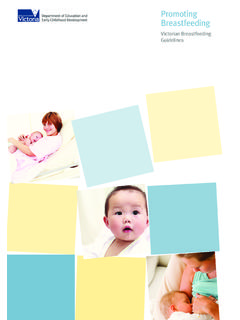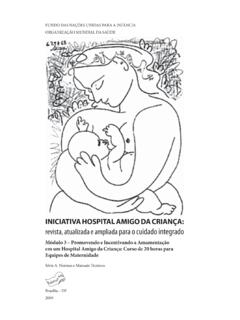Transcription of Breastfeeding the smart choice: Stepping up to Baby Friendly
1 2017 Introduction The baby - Friendly hospital initiative (BFHI) was initiated by the World Health Organization (WHO) and the United Nations Children s Fund (UNICEF) in 1991. The BFHI has a simultaneous focus on the role of health services in protecting, promoting, and supporting Breastfeeding and on the use of Breastfeeding as a means of strengthening the contribution of health services to safe motherhood, child survival and primary health care in general" (45th World Health Assembly-WHA-1992). The BFHI is embodied in the Ten Steps to Successful Breastfeeding , also called the Global Criteria, and the International Code of Marketing of Breast-milk Substitutes describing the minimum standard of care for newborn infants (including information supporting infants in the special care nursery as appropriate). The BFHI was revised, updated and expanded by WHO/ UNICEF in 2009, based on current research and experience in many countries. The Innocenti Declaration 2005 called on all governments to revitalize the BFHI, maintaining the Global Criteria as the minimum requirement for all facilities, expanding the initiative s application to include maternity, neonatal and child health services and community-based support for lactating women and caregivers of young children.
2 In Canada, the BFHI is called the baby - Friendly initiative (BFI), reflecting the continuum of care. The Breastfeeding Committee for Canada (BCC) BFI 10 Steps and WHO Code Outcome Indicators for Hospitals and Community Health Services describe the international standards for the WHO/UNICEF Global Criteria within the Canadian context. BCC BFI Ten Steps and WHO Code Outcome Indicators 2017 2 The following key applies to each of the 10 Steps in this document: WHO/ UNICEF statement of the Step. Statement of the Step reflecting the Canadian context. Global criteria/ outcome indicators are outlined regarding facility policy, mothers, staff, health care providers (hcp) (including nurses, physicians/midwives), volunteers and documentation, with additional information available in the relevant appendices. For BFI assessment purposes, the facility s documentation and curricula are reviewed during the pre-assessment phase.
3 For the final external assessment, random samples of mothers1, staff, health care providers (hcp s) and volunteers are interviewed and observations are made to confirm the outcomes have been achieved at least 80% of the time. More information about the BFI and the assessment process may be found on the BCC website ( ). As the BFI is a continuous quality improvement strategy, this document will be reviewed regularly. 1 A note on gender Inclusion and the language of this document: Although we use terms such as mother, father, and family in this document, a person-centred approach should be given to all individuals in our care. BCC BFI Ten Steps and WHO Code Outcome Indicators 2017 3 Table of Contents Page The 10 Steps Global Criteria Step 1 4 Step 2 5 Step 3 6 Step 4 7 Step 5 9 Step 6 12 Step 7 14 Step 8 15 Step 9 16 Step 10 17 WHO International Code Compliance 18 Appendices 1.
4 Policy 1. Policy Checklist 19 2. Education & Orientation Education and Orientation Checklist Breastfeeding Education for hospital and Community Health Service Staff and Health Care Providers Support for Mothers Using Human Milk Substitutes Checklist 20 22 24 3. Prenatal Education 3. Prenatal Education Checklist 26 4. Birth and Skin-to-Skin Care 4. Birth and Skin-to-Skin Care Checklist 28 5. Breastfeeding Care Breastfeeding Care Checklist For Hospitals and Community Health Services Breastfeeding Education Materials for Families Checklist 30 32 6. Exclusive Breastfeeding Checklist Data Collection of Breastfeeding Rates Medical Indications for Supplementation Calculation of Breastfeeding Rates Hospitals Calculation of Breastfeeding Rates Community Health Services 33 35 37 38 7. Mother- baby Togetherness 7. Mother- baby Togetherness Checklist 39 8. Responsive Cue-Based Feeding Responsive, Cue-Based Feeding Checklist Initiation of Lactation: Anticipated Behaviours and Feeding Patterns 40 41 9.
5 Artificial Teats 9. Artificial Teats Checklist 42 10. Continuum of Care Continuum of Care Checklist Primary Health Care and Population Health Principles Checklist 43 44 11. WHO International Code of Marketing of Breast-Milk Substitutes WHO International Code of Marketing of Breast-milk Substitutes Compliance Checklist Summary of the WHO International Code of Marketing of Breast-milk Substitutes and Relevant Resolutions of the World Health Assembly 45 47 12. Summary of the BFI 10 Steps 48 BCC BFI Ten Steps and WHO Code Outcome Indicators 2017 4 Step 1 WHO Have a written Breastfeeding policy that is routinely communicated to all health care staff. Canada Have a written infant feeding policy that is routinely communicated to all staff, health care providers and volunteers. Mothers and clients of the facility are aware of the policies and practices supporting Breastfeeding .
6 The manager identifies the infant feeding policy, or areas within the facility s policy statements, which specifically delineates adherence to The 10 Steps to Successful Breastfeeding (The Ten Steps) and protects Breastfeeding by adhering to the WHO International Code of Marketing of Breast-Milk Substitutes (The WHO Code) and subsequent, relevant WHA Resolutions. The manager also identifies practices that support mothers who are not Breastfeeding . The manager describes how health care providers (hcp), staff and volunteers are oriented to the policies and practices. The manager describes the process for policy implementation, review and auditing compliance with the policy. The manager describes how staff members who are Breastfeeding are supported to sustain Breastfeeding . Staff, health care providers, students on placements in the facility and volunteers are oriented to the policy, and new staff members receive a copy of the policy and all are able to access the policy.
7 Documents, including the facility s written infant feeding policy and other existing policies, protocols and clinical guidelines, indicate that the facility provides care to mothers and babies consistent with The 10 Steps and protects Breastfeeding by adhering to The WHO Code and subsequent, relevant WHA Resolutions. Documents show evidence that the policy development process is multidisciplinary with representation by all stakeholders. Documents show evidence of support for staff members who are Breastfeeding . Written information for clients includes easily understood summaries of the policies and practices (or The 10 Steps and The WHO Code), in the languages most commonly understood. The summary of the policy is visible in areas of the facility that serve pregnant women, mothers, infants and/or children and is posted on the facility s website. See Appendix 1: Policy Checklist BCC BFI Ten Steps and WHO Code Outcome Indicators 2017 5 Step 2 WHO Train all health care staff in the skills necessary to implement the policy.
8 Canada Ensure all staff, health care providers and volunteers have the knowledge and skills necessary to implement the infant feeding policy. The manager shows records of orientation of all staff, hcps, volunteers, and students to the Breastfeeding policy and attendance at Breastfeeding education programs, either during their employment, prior to being hired and as continuing education. If new and without prior relevant Breastfeeding education, individuals must be scheduled for education within six months. The manager is aware that, for staff and hcps providing direct Breastfeeding care2, at least 20 hours of education, including three hours of supervised clinical instruction, is strongly recommended. Staff and hcps also receive education on how to assist mothers to make informed decisions regarding infant feeding and to provide support for mothers not Breastfeeding to choose what is acceptable, feasible, affordable, sustainable, and safe (AFASS) in her circumstances.
9 The manager describes how staff and hcps can attain necessary education and skills and how competencies are assessed. Staff and hcps confirm that they have received education appropriate to their role, or if new, have been oriented to the infant feeding policy and practices. All staff and hcps identify that The10 Steps and The WHO Code protect, promote and support Breastfeeding and can correctly answer questions on Breastfeeding protection, promotion, and support appropriate to their role. Documents: The written curricula or course outlines for orientation and education adequately address The 10 Steps and The WHO Code, appropriate to the role of the staff and hcps. The following records are available: record of orientation of staff and hcps to Breastfeeding policy and practices record of attendance of staff and hcps at education programs schedule for education of new staff evidence of ongoing competency validation. See Appendix : Education and Orientation Checklist Appendix : Breastfeeding Education for hospital and Community Health Service Staff and HCPs Appendix : Support for Mothers using Human Milk Substitutes Checklist 2 Direct Breastfeeding care includes any of the following: Breastfeeding education, assessment, support, intervention and follow-up.
10 Peer support counsellors benefit from Breastfeeding education to facilitate the mother-to-mother peer relationship. BCC BFI Ten Steps and WHO Code Outcome Indicators 2017 6 Step 3 WHO Inform pregnant women and their families about the benefits and management of Breastfeeding . Canada Inform pregnant women and their families about the importance and process of Breastfeeding . Pregnant women (at 32 weeks or more gestation) who use a prenatal service and who have had two or more prenatal visits or classes, confirm that they are given sufficient opportunity to discuss their infant feeding decisions with knowledgeable staff. They also confirm that the importance of exclusive Breastfeeding has been discussed with them. These women can describe the importance of Breastfeeding (at least two items) and the importance of skin-to-skin contact, in addition to two of the following: exclusivity of Breastfeeding , risks of non-medically indicated supplementation, responsive/cue-based feeding, position/latch, rooming-in, and sustained Breastfeeding .





